Photos: Richard Lovrich
When Sarah Kinlaw arrived to Basilica Hudson to perform the closing set to 24-Hour Drone, she had been working and traveling for nearly the same timespan as the festival. Having flown out to Los Angeles for a pop performance at the JOAN the day before, she left immediately after her 9 p.m. set, got on a plane, was picked up at JFK airport, driven to the Hudson venue and arrived at Basilica—almost on the minute—for her noon performance art piece.
“I don’t know that I’ll do that again,” Kinlaw laughs. “I took a risk.”
Her set was a meditative and devotional performance art piece that closed the 24 hours with gentle and thoughtful movement and feathery, whispered vocals. A suspended, swinging microphone—which nearly collided with her lips as she ducked and contorted around its path—amplified her voice in quick spurts like passing cars on the highway. The performance artist, musician and choreographer recently spoke with The Collaborative about the fulfillment she feels from performing, her past work and the need to create what she craves.
Sarah Kinlaw: When I was in the car on the way to Hudson, there was a live-stream of the festival and I pulled it up and listened to it as I made my way north. It felt so important to me that I try to connect to what people had been experiencing. Sometimes with durational stuff it can feel very epic, almost like a marathon, very active. As the audience or participant you can choose the level at which you engage. You can check out but no matter what you’re still a part of it. More than anything, I wanted to be a very generous performer.
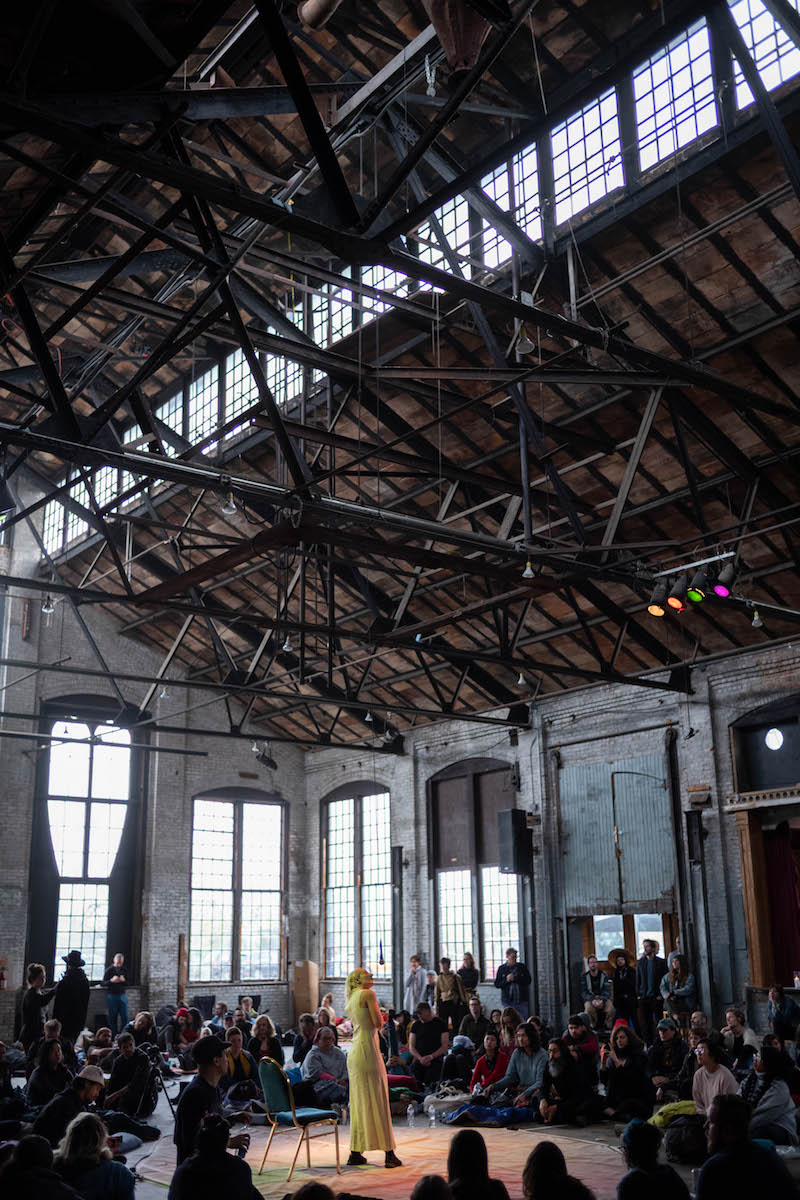
The Collaborative: Watching you take your place on the “stage,” there was such a clear focus in your eyes. How do you get yourself to that point?
SK: My personal life is, let’s just call it dynamic. It feels so hard, sometimes, to be a person. I have to say, I do sometimes struggle with focus and living and listening and being…whatever it looks like to not perform. I have so much appreciation for audience, for people, for higher communication, which is what I consider to be art.
It’s the only time, and this only increases as I get older, the only time I feel comfortable. Regardless of whatever comes before or after—I could be on planes for days, I could be struggling—this is when I truly feel authentically myself and I don’t take these experiences for granted.
It’s not an egotistical thing. Maybe when I was young. When I first started making performances and art I do think it came from wanting to be seen, wanting to show. As the years have gone by its more about trying to strip away what I can so I can be present. I was focused. I felt comfortable. It doesn’t matter what sacrifice came before, it’s about what happened at that time. I don’t like to be an excuse maker and I refuse to be one. Just because I was double booking myself, that’s my business and I don’t want any of that to bleed into my performance. That detail shouldn’t be the audience’s business. They shouldn’t have to feel sympathy for me and I recognize that so clearly.
As far as excuses or breaking down or disconnecting or not doing your best because of the past, I cannot accept that in my performance. Unless it feels like an authentic and driving force towards something important. I take this very, very seriously. It doesn’t matter if it’s in a basement, a bathtub, an institution—and that doesn’t mean it’s always serious work because its not. Sometimes it’s foolish and ridiculous. But it’s still… like praying or something.
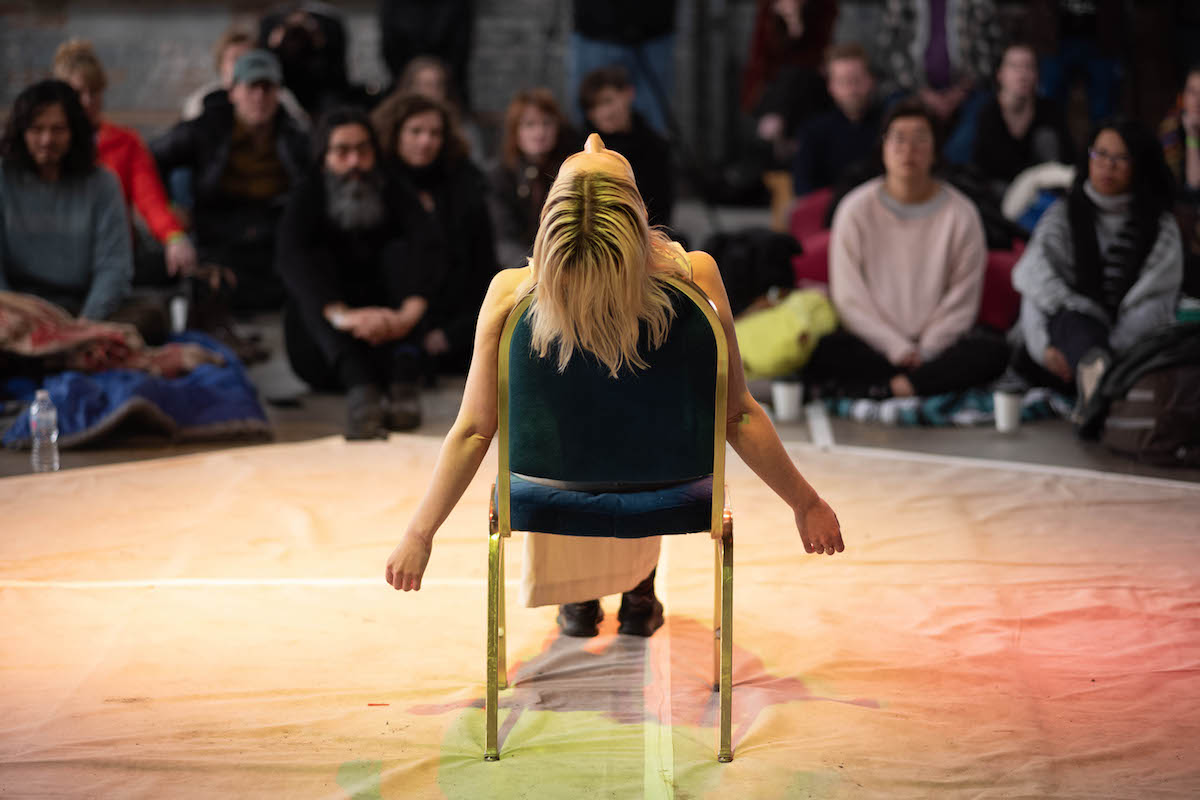
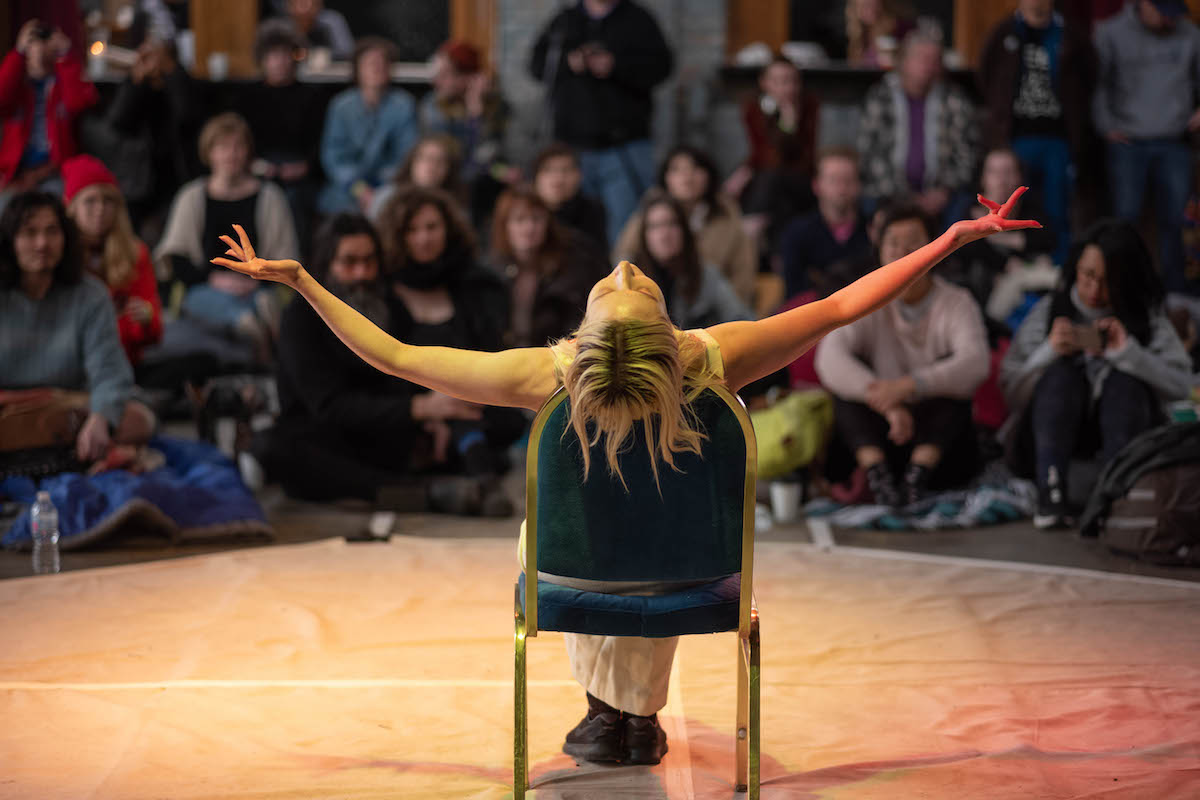
CO: So much of your movement was minimalistic, in terms of choreography. I felt drawn to the slightest bending of your fingers, the way you turned your head, how long you held a pose or where you focused your eyes. There was a lot of power in that.
SK: It was fully in consideration of the space and where people were. Every single time I’m gearing up to do something for people I’m thinking about the people. Where are their bodies? Are they close? Are they far? I didn’t want to make something that felt like show.
When you start getting into physicality and movement stuff you have a choice. There is an artistic decision behind every gesture you make. Are they built for stage? Are they designed for people sitting far away who cannot see your eyes? I knew they were gonna be close.
I’ve been making more of effort to go to things like ballet and symphony, these bigger performances with a lot of seating capacity and sitting in the back row. I might not always enjoy it, but I’m sitting there watching the ballet—and these are some of the greatest dancers in the city—and I’m asking myself, ‘Why am I not having a good time?’ In those moments where I’m checking out, I ask myself, ‘What am I craving?’ I’m craving their eyes. I cannot see them, their eyes are so far.
It’s been one of the gifts of my performance experience, really. I’ve created a lot of shows where people can see my eyes and that matters a lot to me because it’s often the thing I want to see myself. The minimal movements, the subtleties, those things matter. Especially if you can see them. It doesn’t have to be a show, some conjured up and molded performance piece, it can just be connecting. In trying to stay available while you’re performing, it can be subtle. I’m trying to do what I need to do to remain present, as someone who can listen.
CO: I noticed there were elements of the Drone piece that were reminiscent of your MoMA PS1 piece “Unboxing the Compass, Bending the Axis.” Was that intentional? Was there something you wanted to connect between the two?
SK: I did it basically as a nod to people who know how to connect them. I thought it would be interesting. I built the sound piece for Basilica specifically for the show. I found out months ago I would be involved—and I’m always working on a few things at once—but creating the piece for the Drone festival became this time where I would just purge and not be so linear in my thinking, allowing the process to be more therapeutic and holistic and just, more free.
I’ve been thinking a lot about all these different shows I’ve done. For the MoMA piece I was an artist in residence and given a commission by the museum to make a really big show…that meant a lot to me. Recently I’ve been thinking more about how to be more holistic in my output, letting the work I’ve done kind of move into the next so that it’s not just a hard start-stop into another. Always letting the work move from one into the next. That score that I composed was about an hour and involved a lot of live sounds, microphones on the floor and sound responsive structures with choreography. I thought it would be good for me to give that nod to the previous huge score I had made, just to kind of keep things connected. But I will say that the piece was built specifically for Drone and even though I did allude to something, it was just a moment.
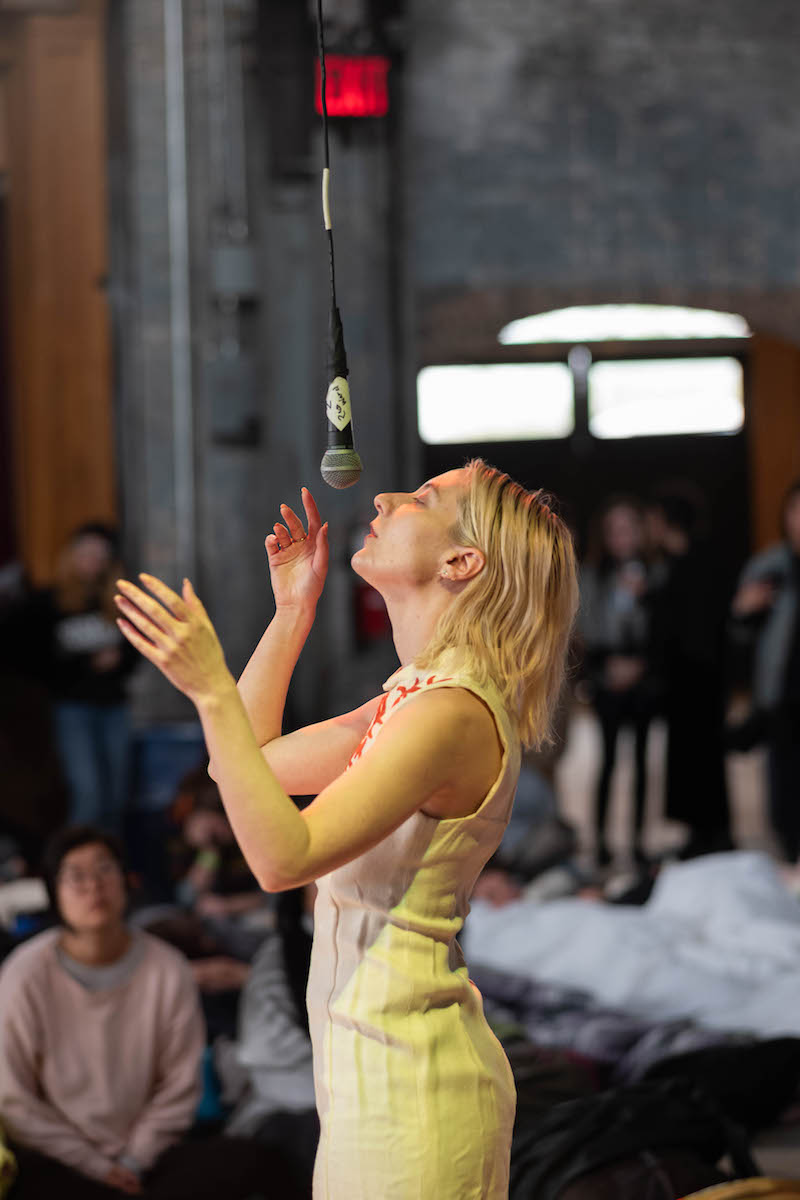
CO: The way the microphone comes into play is really interesting. With the vocals, it felt like there was always almost a word to catch, but not quite. Were there things you wanted people to hear or was it more improvisational?
SK: It’s a very boxed-in improv. I didn’t want to be singing words because I didn’t feel like that was in the theme of Drone. I didn’t want to set many rules but that was definitely one. Drone to me is like a space. It’s a space that I don’t want to get involved in because it’s specific to each individual and I felt that if I came on a microphone and started saying words it would be true to my own experience and narrative—pushing an agenda on people—which is not what I wanted to do.
I wanted vocal texture on it because the sound piece was very low end but I wanted that breathy, pillowy sound. I did not want to distract from people’s headspace and I didn’t want to direct them. As someone who has worked in experimental art in all forms, words are like the most direct thing you can play with. Any time there’s an experimental thing and people start bringing words into the mix, you’re going to listen. Our brains—most of us—want to understand what the words are: What do they mean? Do they exist? Am I understanding it right? We can’t help it. We get involved and we want to follow. We question ourselves and the narrative, if the words are even good.
It was a set of free flow, of the moment, interpretations. It would have been cool to have more of a rehearsal with the movement, because even though it’s loose it would have been good to have almost a choreography with the individual running sound. All of my things kind of bleed together and I view that a lot like a dance, so you’re dancing with the engineer in a very roundabout way. You do these pieces and you think about how, next time you can do this and that. There’s some truth to that, but also it felt beautiful the way it was.
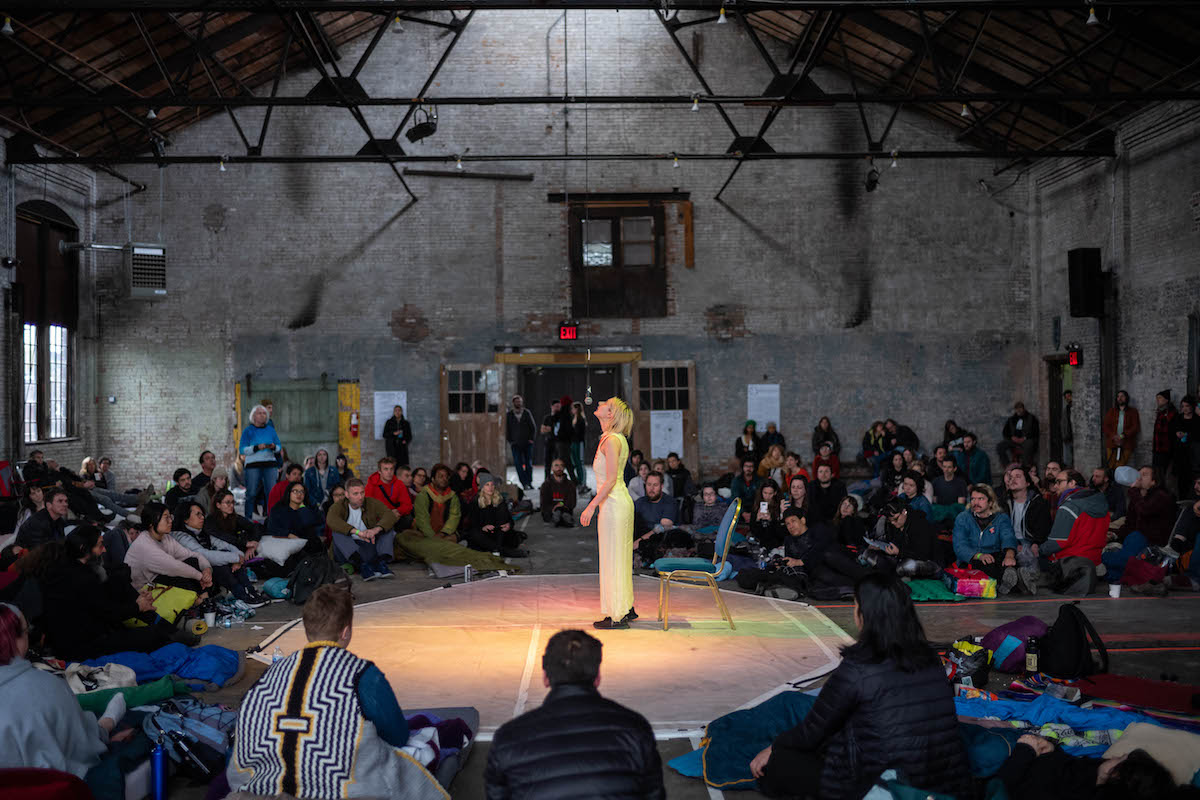
CO: We were lucky enough to document your performance with Open Stage Media and I’ve noticed that’s something you keep pretty good track of on your own website. Are your videos usually more of an archival thing or more utility-based, for grants and such?
SK: More of an archival thing. I just like to see it because I’ll tell you something, it’s hard for me to watch. I can’t stand watching myself after the fact, I would just like to leave it in the present and moonwalk away but I think because it makes me so uncomfortable I should do it.
I’ve tried to become better at archiving performances. Sometimes I’ve pulled them out to apply for grants or for proposals for other events but it’s just educational to watch yourself, especially when it comes to the voice. You’re learning about our physical response to what it is to sing, how sound kind of bounces around our nasal cavities. We hear our voice a certain way in our heads but it never sounds the way we think it does. We are incapable of hearing our own voice, present in our bodies.
As uncomfortable as it can be, I think it’s a cool tool to double back and listen—and watch. Movement will feel so different coming from my body than the way it looks and that kind of disconnect isn’t intentional it’s just the way our bodies are made. That separation is interesting to me. It’s like that iceberg symbol. You’re seeing this bit performed but so much goes into getting the work done, thinking about intention, the bits that go behind performance. So, it’s interesting to look at a piece without any of the backing thought that goes into the creation in the first place.
CO: How long have you been working in the experimental art genre? What led you there in your creative career?
SK: I never really chose ‘experimental,’ or, I don’t really use that word that much but people think I’m an experimental artist, for sure. And I agree with them but I don’t do it on purpose. I try so hard to always be thinking about avenues that I connect with. Like a lot of people, I started out in a more linear way where I was growing up in North Carolina in a bunch of choirs, with vocal teachers, I studied mostly classical music in maybe a more normal way of working my voice and body with teachers. When it started to break was when I moved here after high school and I didn’t really have a path. In having to open the space—feeling stubborn about doing something if I wasn’t going to go to college—I was always playing and moving on to the next thing and in a sense that’s what I’m still doing. I don’t feel like i have to do a certain thing I’m just doing what feels right to me. I feel fortunate that I have different parts of my body I can use—I love using my voice and I love moving my body while being silent. I love directing and holding a camera and making videos for other people. I love working with other artists so they can make pieces. I like staying engaged with the communication of the body, my own mind, my own synthesis of the world.
CO: Sort of just, staying in tune with your process?
SK: Sometimes not being in tune at all, just laughing or being upset about it and letting that be OK too. I’m not always in tune, sometimes I’m totally fucked up and that’s OK. That’s part of what’s real.
I feel like some people, especially during interviews, can turn into art prophets: This is the way, this is the process, this is the linear design for creative work and I am all-knowing. It’s like, no. You’re not. There is no way. I think it’s fascinating that we all get together to try to talk about process and about what is it that goes behind the piece and behind the mind. Sometimes it’s just a system of chance and good and bad luck and, how honest are you willing to be? Are you willing to listen? Do you try or stop trying? I think instead of process and how we get there, it’s winding choices. We choose and don’t choose over and over again and it leads us to these different situations and for me those involve performance but for others it looks like so many different things but we’re all kind of driven by the same motives and the same kind of guidebook and I think that’s what unites us as humans.
It would be a lie for me or anybody to talk about how pristine and clear process is. It’s not a linear thing. Maybe for some it is, who am I, even, to say? It’s just not as clean as it sounds.
Check out Kinlaw’s performance at Basilica Hudson here:





